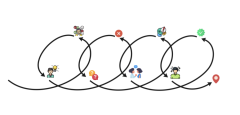
Last week I read a book named 7days in the art world. When I read this book, I mainly focus on the characters in the art world and their relationship.
This book introduced five main roles of the art market: the artists, the dealers, the collectors, the curators, and the critics. The relationship between them like this:

【The connection】
Then I am thinking about the relationship between artists and collectors.A purchase will happen when the buyer has some connection with the artwork. For example, some collectors said they would buy artwork when they feel something, or the artwork helps them understand the way they live.
However, this kind of connection is very personal. Everyone’s ability to appreciate art is different. Appreciation of art is influenced by a person’s past experience, background and other factors. I think that’s the another reason why its hard to sell artworks.
【Takashi Murakami】
In addition, the most impressive chapter is chapter six, which is about visiting Takashi’s studio. This chapter mentioned anti-elitism and the cooperation between Takashi and Louis Vuitton. The artist’s works flatten the distinctions between art and luxury goods, high and popular culture, East and West.
But I can’t agree with that. I searched Takashi’s work online; even printed works are pretty expensive, not ordinary people can afford it. No matter for his artworks or a Louis Vuitton bag. The distinction between high and popular culture is still here.
【Art is far away from our daily lives】
When I searched the review of this book, one reader said: ‘ I am sure that most readers of this book also chose it because we will never be able to attend a Christie’s Post-war art auction, the Venice Biennial, or the Basel Art Fair except through Sarah Thornton.’
I reckon that it’s hard to sell artworks because some people think Art is far away from their lives. For instance, we have to go to specific places, museum or gallery, to learn about Art. And in China, art subject is not as important as Math, Science and English. Only a small percentage of people will be educated in the arts.
Most people lack art education and appreciation ability, so they feel Art is far away from their lives. Therefore, when they see artworks, it is difficult for them to connect with them, so they will not buy them.
【Who is the audience of art student’s work】
Firstly, not those five characters in the book. They are the people who pursuit masters work at a high price.
I sale my watercolour paintings twice when I was undergraduates; the price is 60 pounds for a sheet and 1200 pounds for a set. Unfortunately, I even have no idea who brought my works. I guess the customer is someone who is willing to learn Art and purchase Art, but they can’t afford masterpieces with outrageous prices.
Now, I think my question can evaluate again to:
How can I improve the level of arts education? How can I make art more universal? How to bridge the gap between art and the public?
I think the potential market for Art is enormous. As the book said: ‘Only a century ago, no one had a car. Now, people have two or three. That’s the way it’s going with art’.
Few people knew about Art before because it was a spiritual pursuit. In the age of food scarcity, most people only focused on physical needs, while the upper aristocracy pursued spiritual needs. With economic development, people’s physiological needs have been met, the pursuit of spiritual needs is a trend.
I have no idea who is the audience of art student’s work, and I didn’t find some academic articles related to this question. Maybe my work is to turn ordinary people into an audience for art students’ works. And the plan is through improving the level of arts education to 1)reduce the gap between Art and the public 2) Let more people have the ability to appreciate Art and connect with artworks.
